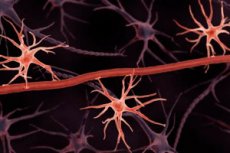New publications
Astrocytes: The Hidden Source of PTSD
Last reviewed: 03.08.2025

All iLive content is medically reviewed or fact checked to ensure as much factual accuracy as possible.
We have strict sourcing guidelines and only link to reputable media sites, academic research institutions and, whenever possible, medically peer reviewed studies. Note that the numbers in parentheses ([1], [2], etc.) are clickable links to these studies.
If you feel that any of our content is inaccurate, out-of-date, or otherwise questionable, please select it and press Ctrl + Enter.

Patients with post-traumatic stress disorder (PTSD) often have difficulty forgetting traumatic memories, even long after the threat has ceased. This failure of the fear "extinction" process has long baffled scientists and has been a major obstacle to effective treatment, especially since existing drugs that target serotonin receptors help only a limited number of patients.
In a new study, researchers from the Institute of Basic Science (IBS) and Ewha Womans University (South Korea) have discovered a new brain mechanism underlying PTSD, as well as a promising drug that can block its effects. The results are published in the journal Signal Transduction and Targeted Therapy.
Led by Dr. C. Justin Lee of the IBS Center for Cognitive and Social Research and Professor Lyoo In Kyoon, the team showed that excess production of GABA (gamma-aminobutyric acid) by astrocytes – the star-shaped support cells of the brain – impairs the brain’s ability to suppress fear memories. This deficit is a key feature of PTSD, explaining why traumatic memories persist long after the threat has ended.
Most importantly, the researchers found that KDS2010, a drug that penetrates the blood-brain barrier and selectively blocks the enzyme monoamine oxidase B (MAOB), which is responsible for abnormal GABA formation, can reversibly suppress PTSD symptoms in mice. The drug has already passed phase I clinical trials in humans, making it a strong candidate for future PTSD therapy.
Key findings of the study:
- Difficulties in treating PTSD are related to the ineffectiveness of current serotonin-based medications.
- The study focused on the medial prefrontal cortex (mPFC), a brain region involved in fear regulation. Patients with PTSD had elevated levels of GABA and decreased blood flow in this area.
- As patients' conditions improved, GABA levels decreased, indicating its critical role in the recovery process.
To find out the source of the excess GABA, the scientists examined postmortem human brain samples and used mouse models of PTSD. They found that GABA is produced not by neurons, but by astrocytes, using an enzyme called MAOB. This abnormal activity suppresses normal neuronal function and blocks the brain's ability to "forget" fear.
When mice were injected with KDS2010, a highly selective, reversible MAOB inhibitor developed at IBS, brain activity returned to normal, fear responses disappeared, GABA levels decreased, blood flow in the mPFC was restored, and fear extinction was restored.
Thus, MAOB in astrocytes was confirmed as a key pathological mechanism of PTSD, and its inhibition as a viable therapeutic option.
A unique approach: "reverse broadcast"
Typically in biomedicine, the research path goes from laboratory models to humans. In this case, the scientists used the opposite strategy:
- First, clinical brain scans of patients.
- Then - the search for the cellular source of the disturbances.
- And finally, confirmation of the mechanism and testing of the drug on animals.
This approach has provided a new perspective on the role of glial cells, which were previously considered to be merely “passive helpers” of neurons.
“This is the first study to identify astrocyte-derived GABA as a key pathological factor in fear extinction deficits in PTSD,” said Dr. Won Woojin, co-author of the paper.
“Our findings not only reveal a new mechanism at the astrocyte level, but also provide evidence for potential treatment with a MAOB inhibitor.”
IBS Center Director Dr. Justin Lee emphasizes:
"This is an example of successful 'reverse' research, where clinical observations in patients led to the discovery of a cellular mechanism.
By identifying astrocytic GABA as a pathological factor in PTSD and targeting it via MAOB, we open up an entirely new therapeutic paradigm - not only for PTSD, but also for other mental illnesses, including panic disorder, depression and schizophrenia."
What's next?
The scientists plan to continue studying astrocyte-targeted therapies for various neuropsychiatric disorders. The drug KDS2010 is already undergoing phase II clinical trials, and if its effectiveness is confirmed, it could lead to new treatments for PTSD in patients who do not respond to traditional approaches.
